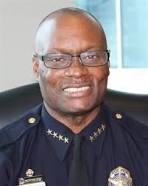Dallas Police Chief, David O. Brown, once said that “trust is hard to earn and easy to lose.” Since taking the reins of the police force in 2010, Brown has taken that principle to heart, transforming Dallas into a national symbol of community policing even as the department grapples with the tragic killing of five of its officers earlier this week.
“All I know is that this must stop—this divisiveness between our police and our citizens,” Brown said at a mournful press conference on Friday. “We don’t feel much support most days. Let’s not make today most days.”
If the Dallas Police Department has now become a poster child for police reform due to Brown’s efforts to increase transparency and train officers to reduce the lethality of interactions between police and the community, that was not always the case. Dallas was once notorious for police violence. For years, the third largest city in Texas has had a higher per-capita rate of police-involved shootings than Chicago, New York, or Los Angeles.
This trend began to reverse around four years ago. On July 24, 2012, a Dallas police officer shot and killed James Harper, an unarmed black man. Residents took to the streets. A confrontation with police appeared imminent. But despite the potent and often combustible combination of angry citizens and riot police, a concerted effort by both sides kept the streets relatively peaceful.
In the wake of this near catastrophe, Dallas embraced a new model of community policing which Brown announced over Facebook. “The citizens of Dallas have shown great trust and confidence in the Dallas Police Department,” Brown wrote at the time. “My pledge is that we will continue to work as hard to maintain and improve citizens’ trust as we did to earn it.”
The department committed itself to transparency. It developed a new foot pursuit policy that emphasized de-escalation. One proposal would make police officers in Dallas subject to lethal force training every two months instead of every two years. Brown released an enormous amount of police data, too, publishing statistics including 12 years worth of data on police shootings on an official online repository. The number of body cameras used by officers increased. Poor performing police officers were fired. And after Brown declared that traffic citations were not intended to “raise revenue,” his officers issued half as many tickets at last count as they did in 2006.
Although widely praised for these efforts, Brown and the department’s top brass have also come in for criticism from city council members, police associations, and others who have called their tactics unsustainable. Officers have been voting with their feet as well: At least 143 individuals have left the department, while recruitment has stagnated. Academy classes are regularly canceled for lack of applicants.
But crime statistics seem to validate Brown’s work. In 2014, Dallas had its lowest murder rate since 1930. Overall crime decreased by 4.5 percent last year while violent crime dropped at a similar clip. There have been ups and downs, including a dramatic uptick in murders this year, but the trend line appears to hold true: Dallas is a less violent city than it was five years ago.
Some point out that police reform may not be responsible for plummeting crime rates. But, at the very least, Dallas police appear to have cleaned up their act. Excessive force complaints against the department dropped by 64 percent over a five-year period. Arrests are decreasing by the thousands each year.
“So far this year, in 2016, we have had four excessive force complaints. We’ve averaged between 150 and 200 my whole 33-year career. So this is transformative,” Brown told a crowd of his fellow officers and policymakers at the White House in April. His department is a member of President Obama’s Police Data Initiative. “And we’ve averaged between 18 and 25 police involved shootings my whole career. We’ve had two so far this year.”
With around eight months remaining in the year, however, Brown was painfully aware of how fickle such trends can be regardless of the department’s best efforts. “Knock on wood, brother” he concluded after discussing these trends, rapping his knuckles on the wooden podium in front of him. “Knock on wood.”
As the city of Dallas grieves for the five police officers killed Thursday night, these statistics will offer little succor. But the legacy of these reform efforts, and the trust they engendered, does offer hope that the city may be prepared to begin to heal its wounds in the days and weeks ahead.
This article is part of our Next America: Criminal Justice project, which is supported by a grant from the John D. and Catherine T. MacArthur Foundation.
http://www.theatlantic.com/politics/archive/2016/07/dallas-police/490583/


